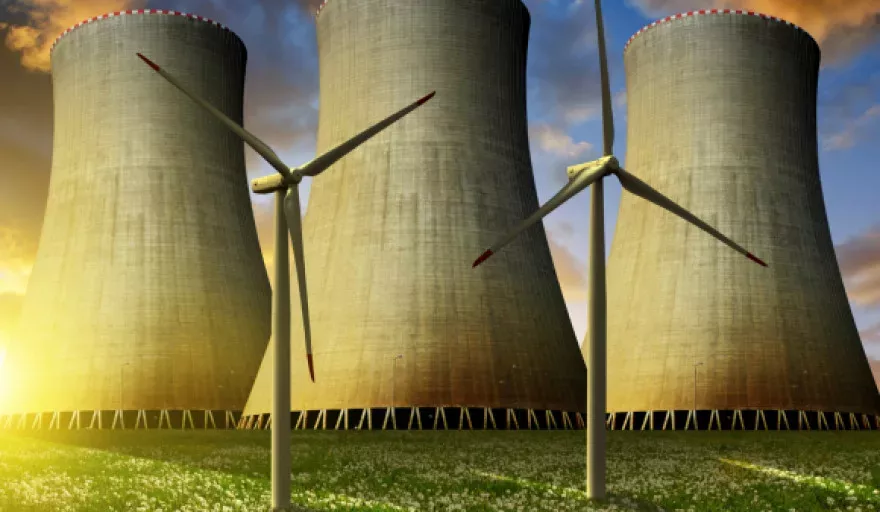On 12 December, 2015, after complex and lengthy negotiations, 195 countries adopted the Paris Agreement under the UN Framework Convention on Climate Change. The Paris Agreement only comes into force once it has been ratified by 55 signatories to the Convention, who must account for at least 55 percent of the total global greenhouse gas emissions.
UK EMISSIONS TARGET
The headline provision is that global efforts must be made to keep the increase in the global average temperature below 2°C above pre-industrial levels. With the text of the Convention making clear that this limit is under significant threat, and in light of the UK Government’s contentious new renewables policy, it is an opportune moment to analyse whether the Paris Agreement will change UK Government policy towards renewables.
In November, 2015 a letter by Amber Rudd, the Secretary of State at the Department of Energy & Climate Change (DECC) – indicating that the UK might fail to meet its legally-binding emissions reduction target – was leaked to the press. In the letter to fellow members of the Cabinet, Rudd stated that according to internal central Government forecasts which were not in the public domain, the UK is set to miss its renewables target.
The shortfall is significant. The target requires 15 percent of the UK’s final energy consumption across electricity, heat and transport to be from renewable sources by 2020; and based on current efforts, the UK will fall short of this by 3.5 percent percentage points, equivalent to around 50TWh.
The apparent acknowledgement that the UK is struggling to meet its renewables target is surprising considering the Government’s strong statements of confidence in the UK’s ability to meet the target. Given what the statistics show, it would be natural to expect the UK Government to give greater support to the renewables sector and its approach to rely on the market contrasts with both the need to meet the renewables target and the spirit of the Paris Agreement.
Article 4 of the Paris Agreement states that “Developed country Parties shall continue taking the lead by undertaking economy-wide absolute emission reduction targets”, whilst Article 10 acknowledges that “accelerating, encouraging and enabling innovation is critical for an effective, long-term global response to climate change”.
The UK Government’s recent actions stand in stark contrast to these obligations. It has made substantial reforms to the Renewables Obligation – historically, the main support mechanism for the renewables sector – closing it to large-scale solar PV from 1 April, 2015 and announcing that it would be closed to large-scale onshore wind from 1 April, 2016.
While these adjustments were in response to an increase in the Government’s liabilities under the Levy Control Framework – from a budgeted £7.6 billion in 2020-2021 to a projected £9.1 billion – the Government’s changes came as a surprise to the market. When considered alongside the removal of the Government’s grandfathering policy for biomass conversion and co-firing stations and the ability to obtain pre-accreditation under the Feed in Tariff scheme, this raises the question of whether the result will inhibit the nascent renewables sector.
What is clear is that while Article 9 of the Paris Agreement notes that “developed country Parties should continue to take the lead in mobilising climate finance from a wide variety of sources, instruments and channels, noting the significant role of public funds”, in the UK, the Government has decided that the renewables sector is well placed to survive market forces with minimal government financial assistance.
ENERGY SECURITY AND NUCLEAR POWER
In a speech given on 18 November, 2015, Amber Rudd stated that “Energy security has to be the number one priority”. Energy security, which means security of supply, is a recurring theme in recent Government statements and helps to explain the contrast between the Government’s state aid for the nuclear sector and the reduction in support for the renewables sector. Notably, when Rudd made significant changes to the financial support available for renewables, she warned that “we also want intermittent generators to be responsible for the pressures they add to the system when the wind does not blow or the sun does not shine”.
Rudd also added: “The challenge, as with other low carbon technologies, is to deliver nuclear power which is low cost as well. Green energy must be cheap energy.”
With a contingent liability of £2 billion in the form of a Government-backed guarantee, and a guaranteed strike price of £92.50 MW/h, Hinkley Point C benefits from significant financial support from the Government and can hardly be described as “low cost”. However, it is clear that the Conservative Government considers nuclear technology as a “low carbon technology” alongside the more traditional renewable energy sources in sharp contrast to the approach taken by the previous coalition Government.
Indeed, Rudd has said that the new generation of nuclear power stations “could provide up to 30 percent of the low carbon electricity which we’re likely to need through the 2030s and create 30,000 new jobs. This will provide low carbon electricity at the scale we need”.
The Government will also open a consultation early in 2016 on closing all existing coal-powered generating stations by 2025, which will have an impact on capacity and so it is not surprising that the Government is looking to build a new wave of nuclear power stations to fill the capacity gap. The long-term impact on renewable energy remains to be determined.
THE THIRD CFD AUCTION
After much rumour, the Government has announced that there will be a further three CFD auctions, the first of which will take place by the end of 2016. Under the scheme, renewable energy projects bid for “Contracts for Difference” in an auction round to secure a guaranteed minimum price at which they can sell electricity.
However, Rudd has announced that support “will be strictly conditional on cost reductions”, the Government “will not support offshore wind at any cost” and that there are no more “blank cheques” for renewable energy. The last CFD auction awarded contracts worth £315 million. The amount available for allocation in the 2016 auction is not yet known.
Whilst this decision may seem surprising in the light of the Government’s reluctance to provide financial incentives for renewable energy, it provides a key insight into the Government’s energy strategy and it is clear that the Government is not leaving the renewables sector entirely unsupported. As Rudd made clear in her November speech, she is expecting “a large increase in renewables over the next five years and in the longer-term, new nuclear”.
Alongside the potential for the removal of all coal-powered generating stations by 2025, the Government appears to be hopeful that it can abide by the terms of the Paris Agreement by offering reduced Government financial support to the renewables industry in the form of CFDs in the short to medium-term and by a large increase in the deployment of nuclear power over the long-term.
THE FUTURE OF UK RENEWABLES
The Paris Agreement is the first international treaty which explicitly binds all countries to a tangible target to deal with Climate Change. Its existence is a manifestation of the increasing international consensus that something must be done to halt global warming on a multilateral basis, even if this imposes pressures on individual countries.
However, the Agreement reflects an awareness that nation states will not accept unduly high costs. Article 13 specifically states that “the transparency framework shall…be implemented in a facilitative, non-intrusive, non-punitive manner, respectful of national sovereignty, and avoid placing undue burden on Parties”. In keeping with this statement the UK, which contributes only 1.2 percent of global emissions, is concerned to ensure it does not bear too high a burden.
The renewables industry in the UK is still coming to terms with the dramatic shift in the Government’s renewables policy and reduction in financial support. The three planned CFD auctions currently constitute the Government’s main financial support for the renewables sector under Article 9 of the Paris Agreement.
Under the Paris Agreement, it is the responsibility of national governments to, at the very least, encourage the spread of renewable technology in order to combat climate change and encourage sustainable growth.
It appears that the Government will seek to meet this obligation by relying on a new generation of nuclear power stations coming online and the ability of the UK renewables sector to withstand the full brunt of market forces without Government subsidy. Whether the nuclear power stations will come on line in time and whether the renewables sector can operate without Government subsidy is a big gamble and will determine whether the UK meets its existing target under the Climate Change Act, its obligations under the Paris Agreement and delivers security of supply.




















